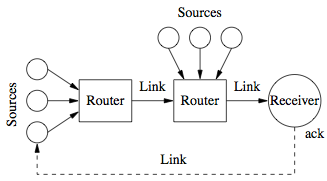Congestion control
The Internet has two control protocols that regulate its behavior: the Transmission Control Protocol (TCP) for end-to-end network communication and the Internet Protocol (IP) for routing packets and for host-to-gateway or gateway-to-gateway communication. A message sent by a source computer is split into several packets that are transmitted over (potentially) different paths in the network, and the packages are rejoined to recover the message at the receiver. An acknowledgment ("ack") message is sent back to the sender when a packet is received. The control mechanism in TCP is based on conserving the number of packets in the loop from the sender to the receiver and back to the sender. The sending rate is increased exponentially when there is no congestion, and it is dropped to a low level when there is congestion.
Modeling
To derive an overall model for congestion control, we model three separate elements of the system: the rate at which packets are sent by individual sources (computers), the dynamics of the queues in the links (routers) and the admission control mechanism for the queues. The figure at the top of the page is a block diagram of the system.
Further Information
- S. H. Low, F. Paganini and J. C. Doyle. Internet congestion control. IEEE Control Systems Magazine, pp 28-43, February 2002.
Frequently Asked Questions
